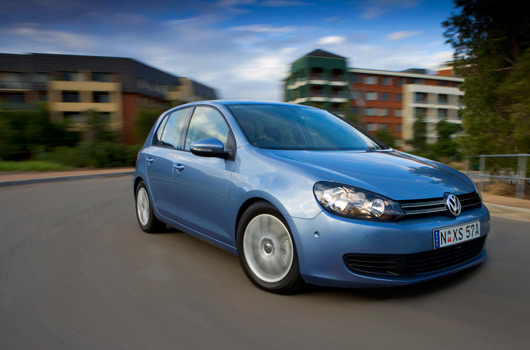
With the launch of the new Mk6 Golf there has been some criticism that it is too much like the old model. Outwardly, despite sharing just one panel from the Mk5 (the roof), the Mk6 is a small progression from the previous model. Although, trainspotters, like myself, could spot the differences a mile away, the average punter will be hard pressed to do likewise. Indeed, it has been suggested that the Mk6 should simply be called a Mk5.5, in that it could be considered only half an upgrade.
Merits of that argument aside, it turns out that the new Golf actually is an old Golf. Or, more strictly, a recent independent audit has found that over 500kg of the car’s total weight contains recycled materials.
German authority TÃœV NORD has assessed 5,000 parts and found that there is 527kg of recycled materials used in the production of the Mk6. The bulk of the recycled matter is metal (501kg), with plastics next (15kg), followed by glass (9kg) and operating fluids (2kg).
According to the Australian specifications released with the local launch of the Mk6, the range here tips the scales from 1270kg for a 6-speed manual 90TSI, to 1380kg for a 6-speed DSG 103TDI. Assuming the 527kg recycled material figure is consistent across the model line up, that represents 41.5% recycled materials used to build a 90TSI, or 38% for a 103TDI.
The mid-weight locally is the 118TSI, which weighs 1330kg when fitted with a 7-speed DSG, and that would mean 39.5% of the car’s weight is reused matter. The spec sheets claim the DSG transmissions weigh 20kg, so add half a percent or so to those figures if changing your own gears is your thing.
Understandably, most consumers focus on fuel consumption and CO2 emissions when considering their next purchase. However, it is pleasing to see that a more holistic approach to sustainability is being taken by car makers. Further to that approach, over 85% of Volkswagen vehicles can be recycled at end of life.
Over 500 kg of Recycled Materials in New Golf
Official confirmation from TÃœV NORD
Wolfsburg, February 20, 2009 – Volkswagen commissioned an audit into the use of secondary raw materials known as recyclates in the new Golf. The investigation showed that 527 kg of secondary raw materials, or over 40 percent of the vehicle weight, are used in the new Golf, thus conserving resources. As a result, the new Golf not only excels with its efficient TSI and common rail engines, but also through the use of environmentally-friendly materials. This is the first time that an audit into the use of recycled materials in a complete vehicle has been conducted and certified by the TÜV technical inspection authority.
The systematic use of recycled materials at Volkswagen represents a careful and environmentally compatible approach to primary raw materials and reflects the capabilities of modern vehicle production. The metal life cycle is crucial to an overall ecological assessment of the vehicle. 501 kg of metal recyclates are used in the Golf, thus making an important contribution to conserving resources. Plastics account for 15 kg of the total recyclate weight, glass for 9 kg and operating fluids for 2 kg. TÃœV NORD has certified these results. Some 5,000 parts were assessed during the audit.
Dr. Ulrich Hackenberg, Member of the Board of Management of the Volkswagen brand with responsibility for ‘Development’, commented: “By taking effective recycling separation into account as early as the development stage, Volkswagen is making sure that end-of-life vehicles can also be returned to the material cycle.†Dr. Harald Ludanek, Head of Total Vehicle Development and Protoypes at Volkswagen and also the Group’s Vehicle Recycling Officer, added: “A prerequisite for the use of high-quality recycled materials is that sufficient quantities are available for series production. Obviously, they must comply with the same high quality standards that Volkswagen sets for primary raw materials. The demanding specifications for surface quality and material durability referred to these materials guarantee the safety, reliability and longevity of our vehicles.â€
Conserving primary resources and closing material cycles is an important goal for product development at Volkswagen. This is why the use of quality-assured recycled materials in almost all vehicle parts is not only permitted, but proactively encouraged. Recyclates, which can replace primary materials and therefore contribute to the efficient use of resources, are obtained by treating production residue or from used materials.
Between 2000 and 2006, Volkswagen and its partner SiCon successfully developed the award-winning Volkswagen-SICON method for treating shredder residue from recycling end-of-life vehicles. This economically viable method has a proven recycling rate for present-day vehicles in excess of 85%. While metal recyclates are returned to the cycle in the form of new metal materials, granulated plastic waste, for example, is used as a reducing agent in blast furnaces. More information on the Volkswagen-SiCon method is available from www.volkswagenag.com.